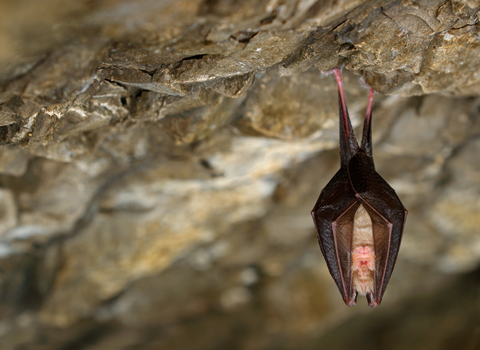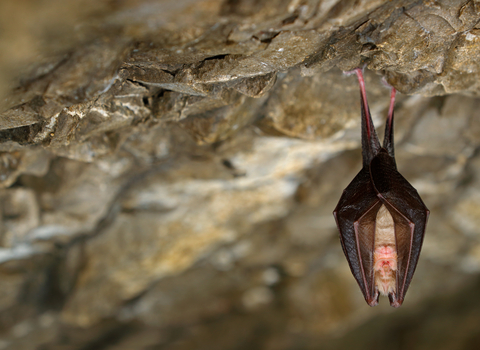
Lesser horseshoe bat ©Shutterstock
Lesser horseshoe bat
The lesser horseshoe bat was once a cave-dweller, but now tends to roost in old buildings, such as stables and barns. It is rare in the UK and, like many other bats, declining in number.
Scientific name
Rhinolophus hipposiderosWhen to see
April to OctoberSpecies information
Category
Statistics
Length: 3.5-4.5cmWingspan: 20-25cm
Weight: 5-9g
Average lifespan: up to 30 years
Protected in the UK under the Wildlife and Countryside Act, 1981. Priority Species under the UK Post-2010 Biodiversity Framework. European Protected Species under Annex IV of the European Habitats Directive.
About
Formerly a cave-dweller, the lesser horseshoe bat now tends to roost in old houses, churches, stables and barns. All UK bats are nocturnal, feeding on midges, moths and other flying insects that they find in the dark by using echolocation. Lesser horseshoe bats feed amongst vegetation in lowland valleys, rarely flying more than five metres above the ground. They may take large prey back to a roost or perch. From May, mixed-sex maternity colonies are formed, and the females have a single pup. Lesser horseshoe bats hibernate over the winter in caves, disused mines, tunnels and cellars.How to identify
One of our smallest bats, the lesser horseshoe bat is the size of a plum. Like the greater horseshoe bat, it has a characteristically fleshy nose that is shaped like a horseshoe. Its fur is grey-brown on its back and white underneath.Distribution
Confined to Wales, western England and western Ireland.In our area
Lesser horseshoe bats are most regularly spotted leaving summer roosts in disused farm buildings and barns, but they retreat to old mines and caves like those at The Stiperstones and at Llanymynech Rocks during the winter.
Visit the NBN website to see all Shropshire records of the species: https://species.nbnatlas.org/species/NHMSYS0000080177#tab_mapView
Did you know?
The generic name of the lesser horseshoe bat, Rhinolophus, is derived from the Greek meaning 'nose crest'; the specific name, hipposideros, means 'horse-iron' or horseshoe. This name refers to the complex noseleaf of this bat, which is thought to focus the echolocation pulses that it emits to find its prey.Lesser horseshoe bats are most regularly spotted leaving summer roosts in disused farm buildings and barns, but they retreat to old mines and caves like those at The Stiperstones and at Llanymynech Rocks during the winter.
Visit the NBN website to see all Shropshire records of the species: https://species.nbnatlas.org/species/NHMSYS0000080177#tab_mapView

